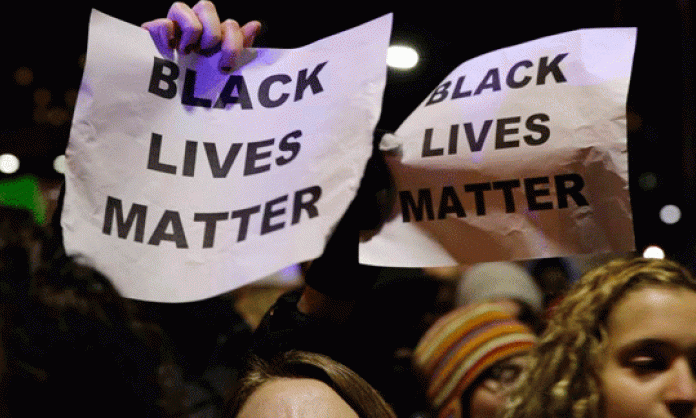Tens of thousands gathered in the North Carolina capital of Raleigh on 14 February for what organisers have called the largest civil rights rally in the US south since the Selma, Alabama, march in 1965.
The Mass Moral March is held annually to protest the right wing state government’s attack on voting rights, education, the environment, health care and women’s rights.
Republican-controlled states like North Carolina spearhead the ruling class attacks on workers and minority groups. The Democrats present a more moderate face, but tail the Republicans. The result is that capitalist politics has moved to the right in recent decades.
The large size of this year’s march reflects the mass actions nationwide against police murders of Blacks, which began in Ferguson, Missouri, last August and continued through the Martin Luther King demonstrations in January.
Many people at the rally carried signs reading “Black Lives Matter”.
These annual marches are in part built through regular actions in North Carolina called “Moral Mondays”. There have been more than 200 such events around the state.
Two of the speakers at the rally were relatives of young people murdered in North Carolina. One was Pierre Lacy, the brother of Lennon Lacy, an African American teenager who was found hanged under mysterious circumstance last year in Bladenboro, in the south of the state.
The hanging recalled the thousands of lynchings of Blacks, which were part of the terrorist reaction, following the Civil War and Reconstruction, that established and defended the Jim Crow system of segregation. A new study has concluded that there were nearly 4,000 such lynchings over a period of more than 80 years.
Reverend William Barber, state president of the National Association for the Advancement of Colored People (NAACP), helped organise and lead the rally. He said of Lennon Lacy: “He was found hanging, had the wrong shoes on. Our own independent pathologist said there was no way he could have done this to himself.
“We’ve called for an independent investigation. And nationally, the NAACP has also said the federal government ought to step in around the case of these three young Muslim students that were killed.
“These hate crimes are serious, and we need to make sure that they are investigated and that justice occurs and that we say that this kind of hate and violence has no place in our American society.”
The three young Muslim students Barber referred to were murdered recently in Chapel Hill, near Raleigh. One of those murdered was Deah Barakat.
His brother, Farris Barakat, spoke at the rally. “A few days ago, my brother, his wife [Yasor Abu-Salha] and my sister-in-law’s sister [Razan Abu-Salha] were tragically murdered in my brother’s apartment”, by a racist neighbour.
“My brother paid with his life. My sister-in-law paid with her life. Razan paid with her life. They paid for their lives because they stood for something that was demonised in the media … and that maybe we haven’t collectively stood up yet to say, that Muslims are Americans, too.”
This was another instance of anti-Muslim violence, which is on the increase in the United States. In the same week as the Chapel Hill killings, a mosque was burned down in Texas.
Meanwhile, on the same weekend as the North Carolina march and rally, there was a protest of another police killing on the other side of the country, in Washington state.
This time it wasn’t an unarmed Black man gunned down, but an unarmed Mexican-American in the small city of Pasco. Someone recorded a video of the murder, which shows three cops chasing Antonio Zambrano-Montes as he ran from them.
He turns and swings his hands upward, before he is felled by a spray of bullets, his body slamming into the concrete. The video was widely distributed on the internet, including in Mexico, prompting condemnation from Mexican president Nieto.
Like many in the Latino community in Pasco, Zambrano-Montes came to the US to work as a labourer in the region’s agricultural fields and orchards. Washington is famous for its apple crop. Latinos make up 56 percent of Pasco’s population, but the city’s power structure remains largely white.
“As with Blacks in Ferguson”, a New York Times reporter noted, “the killing has intensified feelings among Hispanics that they remain second-tier residents, despite their deep roots here”.
The video “has been a near constant presence here”, the reporter said, “Played repeatedly on television news in crowded taco shops and bakeries, each time drawing the gaze of those perched over plates of pupusas or pan dulce.
“Reyes Juarez, 54, said she has slept little since viewing it, imagining her own son gunned down each time she shuts her eyes.”
“It’s like having the badge gives you the right to take the life of a Mexican”, Juarez said.
“They had him like a deer, hunting him”, said Maria Paniagua, 41, who has six children. “What happens when one of my kids gets in a jam and runs? Will they shoot him down?” As in Ferguson, the protests in Pasco reveal anger bubbling beneath the surface. Alicia Coria, 18, was one of the protest leaders. “People are finally getting their feelings out through this whole Antonio issue”, she told the Times reporter. “The Hispanic community is finally trying to have the power.”










